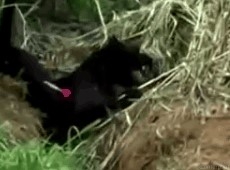There is an old and very wise Native American saying, “Every time you point a finger to blame someone—there are three remaining fingers pointing right back at you.”
With the death of the black leopard has begun what is very much the national pastime in Sri Lankan conservation circles, The Blame Game. These so-called “conservationists” are venting their assaults and irrational denunciations on the wildlife veterinarians for the demise of a black leopard that was recently rescued from a poacher’s snare. The reason to underline “poacher’s snare” is to make sure we do not forget what caused the grievous injuries to the leopard that killed it.
Some have commented that the leopard seemed to have recovered well and should have been released without being further confined. What is not known to most people is that any animal that has been injured by any type of constriction around its body should never be released immediately. Even if there are no obvious wounds, very often the constricted area will start to breakdown after a few days through a process known as pressure necrosis and will become a deep, infected wound and if a limb was caught in a snare then it would lead to ischemic necrosis where loss of blood flow to bone tissue will cause the bone to die.
On a daily basis these same wildlife vets treat and save a huge number of wild animals that come to them shot, maimed, injured or sick. Given the conditions and minimum facilities that are available to them to treat these animals it is not an exaggeration to compare them to warriors fighting a war without weapons. A vet from a developed country would be quite helpless and baulk at the very idea of treating animals with such scarcities and minimum facilities our wildlife vets work every day and still manage to treat animals successfully—even elephants that have had their mouths blown up by Hakka Pattas (oral explosive devices) have been treated successfully by these vets.

If the leopard had survived these very same vets would be hailed as heroes. Unfortunately it died. But don’t forget the fact that the black leopard is just one animal among the thousands of animals that die as a result of poachers. So where is the public outcry???
If the “so called wildlife loving public” without attempting to make scapegoats of the Wildlife Department veterinarians for the death of one black leopard, rather vent their infuriation at the relevant powers that be to take necessary actions to control poaching then we might get somewhere.
One of the greatest tragedies of our times is poaching
It is disgraceful that being a predominantly Buddhist country, poaching is epidemic in Sri Lanka. This means that the entire political, development, education, religious, economic, and social systems of the country has failed. That means this issue has to be addressed through these institutions as well. Many of the poachers the Sri Lanka Wildlife Conservation Society (SLWCS) has reached out to have stated emphatically that they are poaching because they did not see any other options to further their lives economically and socially. Others have affirmed that they do not believe in religion or God. Most of these poachers have attended school up to some level while some are illiterate but have astounding self- knowledge. The big question is? When will we recognize the rampant poaching that has become a plague and a pernicious killer of our valuable wildlife and do something about it?
Keep in mind there are three fingers pointing at you!
Ravi Corea is the President of the Sri Lanka Wildlife Conservation Society and can be reached at ravi@slwcs.org





